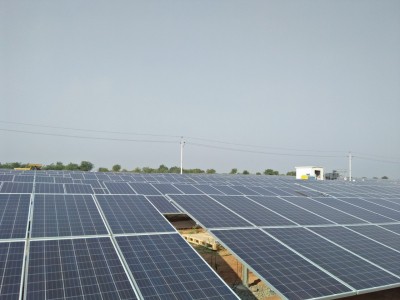
New Delhi, India's total installed solar power capacity would need to increase to 5,630 gigawatts (GW) if the country wants to commit to achieving net zero greenhouse gas emission by 2070, according to a study by the Council on Energy, Environment and Water (CEEW).
"For 5,630 GW solar power, consequently, the total corresponding land requirement for India's power generation assets, especially solar, would be approximately 4.6 per cent. India would also need to develop the requisite recycling capacities to handle the solar PV waste generated," the CEEW study said.
At present, India has 100 GW of installed renewable energy (RE) capacity, of which solar comprises 40 GW, and it aims to enhance the RE capacity to 450 GW by 2030.
Net zero is a concept where a country, a region or for that matter an office, basically any unit, withdraws or mitigates as much carbon emission as it requires.
Ahead of the annual United Nations climate change conference, which will begin in Glasgow in three weeks' time, the developed countries are putting pressure on the developing world, including India, to raise their respective climate action goals and commit to net zero by 2050.
'Implications of a Net Zero Target for India's Sectoral Energy Transitions and Climate Policy', a first of its kind study by the CEEW, also highlighted that to achieve net zero by 2070, usage of coal, especially for power generation, would need to peak by 2040 and drop by 99 per cent between 2040 and 2060, a CEEW release said.
Further, consumption of crude oil, across sectors, would need to peak by 2050 and fall substantially by 90 per cent between 2050 and 2070.
Green hydrogen could contribute 19 per cent of the total energy needs of the industrial sector. These insights assume that hydrogen would play an integral part in this transition, while the Carbon Capture and Storage (CCS) technology would play a negligible role, the release said.
Further, if India were to attain net zero emissions by 2070, the economic cost of the transition could be around 4.1 per cent of the GDP in the net zero year. But if India were to attain it by 2050, the economic cost would be much higher, around 7 per cent of the GDP in that particular year.
"A breakthrough in CCS technology, as well as low-cost finance, could help reduce the economic cost of the transition," said the CEEW study.
"For vast and diverse developing countries like India, at least a 30-year gap between peaking and the net-zero year would be critical. This will ensure a smooth transition by giving the policymakers and other stakeholders sufficient time to plan and adapt to a new energy system. Also, as we move towards a net zero future, energy prices could rise in the short run and workers that are a part of the fossil-fuel economy could lose jobs.
"Hence, developed countries should offer generous financial and technological support to the developing ones to help them set ambitious goals regarding emissions reduction while ensuring a just transition," said Vaibhav Chaturvedi, Fellow, CEEW.
Arunabha Ghosh, CEO, CEEW, said, "Equity must be at the heart of the net zero debate. Developed economies should significantly advance their target of achieving net zero and not wait till 2050. This will give the developing countries room to pursue a just and sustainable energy transition."
More than 125 countries have expressed their willingness to achieve a net zero future. Even though India is yet to commit to a net zero target, it is the only G20 country to meet its emission reduction commitments made in the Paris Agreement.
It is also a leading partner in the International Solar Alliance and has recently announced the National Hydrogen Mission to push innovation, production, storage and usage of green hydrogen.


.jpeg)

